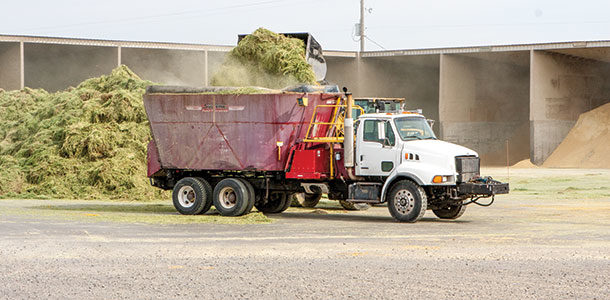Feed more forage. Feed 60, 65, 70 or 75 percent forage to your cows. It’s natural. It’s healthier. I heard my neighbor does it. All the folks on the East Coast feed 70 percent forage. It’s the best way to feed cows. But is it the right thing to do?
The phrase “high-forage diet” is the go-to catch phrase of dairy nutrition that has been splashed across magazines for the last decade or so. It is the 11th commandment of dairy nutrition. When I stop on farms, the nutritionist is often given one clear directive by the producer: “My diet needs to be high-forage.”
But is it the right thing to do? Does it make sense for your farm? Does it matter what forages you use? Will it affect production? Cow health?
Let’s take a look at some diets and we’ll look at some challenges and opportunities (See Table 1).

Diet 1: High-forage, high-corn silage
This is a high-forage (70 percent) diet that utilizes a heavy amount of corn silage. I utilized high-starch corn silage (which I think many folks will see this fall with the bumper 2014 crop) and a mid-grade alfalfa haylage. This diet fits the criteria of being a high-forage diet; estimates of milk production hover around 95 pounds, but there are big concerns.
With a starch level of 30.6 percent and physically effective neutral detergent fiber (peNDF) of 19.2 percent, I would be concerned that this diet has an insufficient amount of fiber and too much starch to maintain a healthy rumen pH.
I would be concerned that most of the carbs are fermenting at the same rate. Yep, despite this diet being 70 percent forage, it might be too hot. This diet could probably be adjusted with a little more haylage, hay or maybe even a little straw; I might also want to replace the high-moisture shell corn with dry ground corn.
Diet 2: High-forage, more haylage
For this diet, I wanted to bump the haylage up. I utilized one low-quality haylage and one high-quality haylage. For the Midwest, this seems to be the norm for inventories (first-cut alfalfa was low-quality for many). This diet is challenging. If a producer is stuck on 70 percent forage, performance will be limited.
This diet can be extremely frustrating to nutritionists who are strapped with a high-forage and high-performance requirement. Neutral detergent fiber (NDF) levels at 32.8 percent will restrict intake, and starch levels near 19.3 percent without another source of fermentable carbs will limit production.
Rumens will likely be healthy, but cows will lose body condition score (BCS). Maintaining 55 pounds of intake is not realistic, and predicted milk production of 83 pounds is optimistic. Forage levels will need to drop in this scenario to improve production.
Diet 3: High-forage, reasonable expectations
Instead of pushing for an extreme diet, many farms are looking for a diet that has more forage than 20 years ago. I think most producers’ true concern is healthy cows. This diet has a relatively high level of forage (65 percent), 63 percent corn silage and is predicted for about 95 pounds of milk.
This diet shows a peNDF of 21.7 percent. PeNDF is a better measurement of effective fiber than forage percentage; it’s not perfect but a better starting point for healthy cows than forage percent.
It gives you a better idea of how well this diet will stimulate rumination and subsequently maintain rumen pH (i.e., healthier cows). Although forage levels are lower than Diet 1, it should be a much safer diet, support high milk production and keep cows healthy.
Diet 4: Mid-forage, healthy cows
This diet is not necessarily better or worse than Diet 3. It has 55 percent forage with 54 percent corn silage (with 5 pounds of cotton). The key is watching the peNDF, which is again at 21.7 percent. This diet on paper supports a couple more pounds of milk than Diet 3. Is it better to have this level of forage (55 versus 65)? I think that’s the wrong question. Both diets will keep cows healthy.
The real question is economics, not forage level
Is Diet 4 (with cotton) more economical (considering forage inventories) when you look at income over feed cost? Do you have value in the cotton in the diet due to particle length on the rest of the diet? Were you able to book cotton at a reasonable price? Do you actually have real values based on your actual expenses for your forages?
So how do we decide how much forage to feed and which ones to plant?
Rather than having a set number of forage percentage in the diet, have a longer conversation with your nutritionist. What are the criteria that will support milk production and healthy cows? Effective fiber, particle length, consistency of diet and sortability should all be considered. These are real factors that affect cow performance. A forage percentage is far too vague to have real meaning in dairy rations.
How much forage is right for my farm?
Although we are always affected by short-term situations (such as drought), sometimes we need to sit back and look to the long term. Run some simulated or hypothetical diets for your farm. Have your nutritionist work through a couple different scenarios:
- If I planted forages 1, 2 and 3, what would my diet look like, and based on today’s prices, which is more advantageous? And then, based on last year’s prices (and prices from five years ago), what would my ration look like? Is it a healthy diet? What is the economic advantage? Are there agronomic restrictions? Soil pH, nutrient management concerns, susceptibility to erosion, value of land, irrigation and growing-degree days are just a few of the considerations. Do you have the harvest equipment you need?
- Using my current forages, let’s run two to four rations with varying levels of these forages. Without putting restrictions on “forage” levels, what would be your ideal ration? Or perhaps, what are two or three different viable options? What would be the benefit of these rations in the long term?
I am not suggesting switching forage levels or types overnight and then switching them every month based on economics. Cows crave consistency. But think beyond today. Get past the “high-forage” requirement. Move to a ration that keeps the rumen healthy, keeps the cows healthy and increases your profitability. PD
Photo by PD staff.

Paul Dyk
Dairy Technical Service Manager
Quality Liquid Feeds










